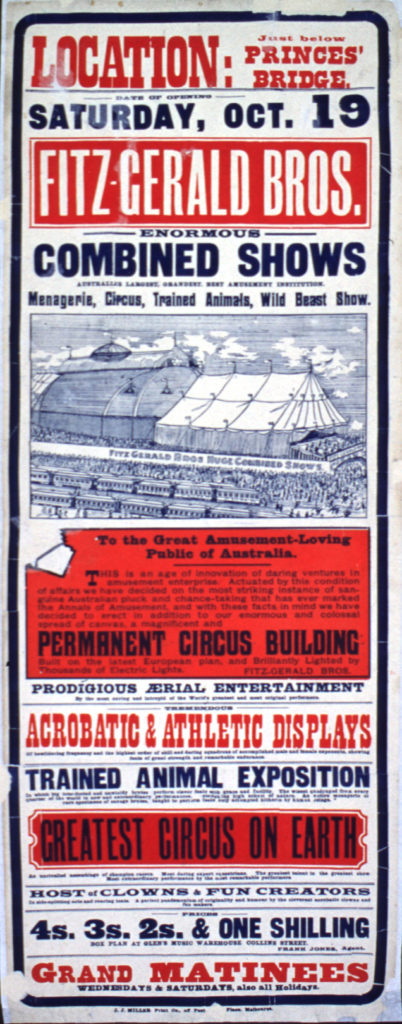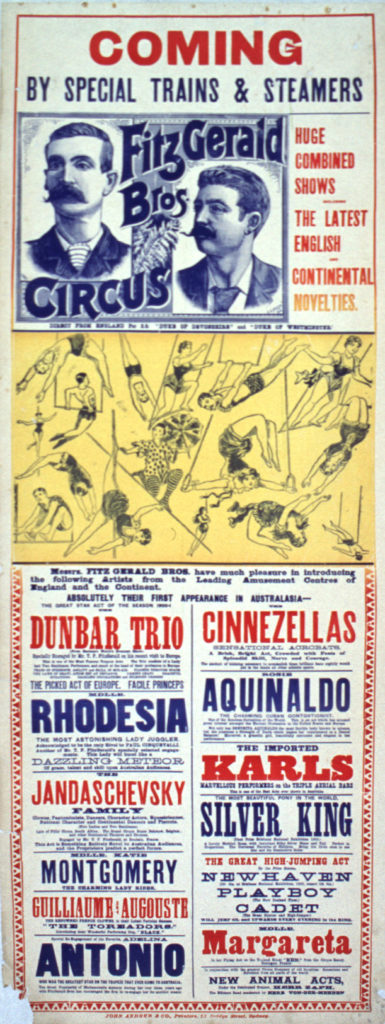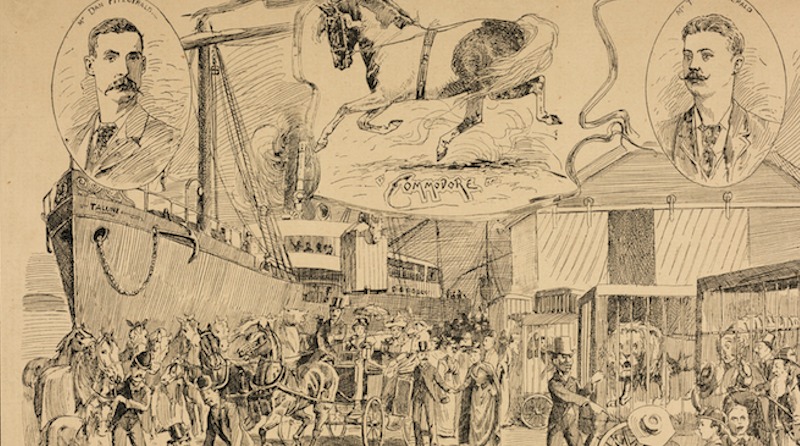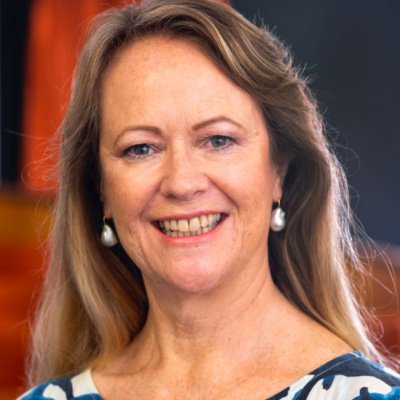Australian Circus at the Hub of Global Entertainment: Histories and Consequences
In the continuing series titled Adventures in Circus Research curated by academic, author, and educator Alisan Funk, we will explore the depth and breadth of circus academic research around the world. By featuring circus researchers, we give them the space to explain the nature and significance of their research directly to the circus community, and to highlight the practical impact of their research on the circus world.
Dr. Gillian Arrighi has approached Australian circus history from a breadth of perspectives. She has traced the important events and players of the past in Australia and New Zealand. She has compared circus histories with other performance genres (Sumo, theatre, amusement parks, variety shows, etc.), and she has tried to understand the situation of child performers within the traditional circus. She is also dedicated to understanding current circus practices. She has written comparisons of traditional and contemporary values in circus arts, explored the importance of community and social circus practices, and has questioned the field of circus studies itself. She is the editor of the forthcomingCambridge Companion to the Circus, is the senior editor of the journalPopular Entertainment Studies (which she co-founded in order to support more publication of circus studies) and continues to inspire scholars to circus research in her role as senior lecturer at the University of Newcastle in Australia.
I chose circus as my primary research focus because I’ve always been drawn to the idea and lived experience of being a peripatetic performer, regularly on the move, planning the next show whilst on the road.
My early career training was as an actor. In the mid-1980s I completed a full-time three-year training at The Drama Studio (Sydney). Prior to this, I had done undergraduate Bachelor of Arts courses at Victoria University in Wellington (New Zealand) and at the University of New South Wales (Sydney), in Classics, Drama, English Literature, and Philosophy. Following completion of the intensive three-year actor training, I travelled to Spain to study Flamenco dance in Madrid and Cordoba. My acting program introduced me to physical training for expressive performance as well as several forms of dance, including Flamenco, to which I was strongly attracted.

After returning to Sydney from Spain, I resumed the professional position of a young actor in the market for work, with the usually busy schedule of auditions in advertising, theatre, and film. I quickly became a little unsatisfied with the absence of aesthetic contribution or artistic input I was required to offer in the professional rounds between actor’s agent, advertising agencies, and general calls from theatre companies and casting agents. In collaboration with a colleague I had known throughout university and acting school, we pulled together a group of similarly enthusiastic young actors to devise a theatre show, constructed out of improvisation, commedia dell’arte mask performance, and lots of laughter and comedy. I recall a very large cast presenting a pretty raw show at one of Sydney’s theatres, then getting into a big van a few months later to drive from Sydney to Adelaide for a season at the Adelaide Fringe Festival (1988).
A few months later, the originally large cast had been reduced to three, the show had been revised and cut back to 50 minutes, and our theatre company (named Cahoots) embarked on five years of intensive road touring. Our geographic territory was immense – from the border of Queensland and New South Wales in the north, to Hobart (Tasmania) in the south, Adelaide to the far west, the rural and regional towns and cities in between. In our first year we drove 40,000 kms to perform 200 shows. In time, we diversified our primarily ‘for youth audience’ shows to include work for the street, national museums, and the theatre and our collaborations kept us busy for nearly 10 years. After making my living for over a decade as an actor, I was drawn into the Australian music industry, where I worked for nearly seven years, before embarking on post-graduate study via Masters by Research at the University of Newcastle.
During my 2-year practice-led Masters research project, which focussed on the neutral mask as a training tool for actors, I worked as a research assistant on a project centred on the entertainment industry in London at the turn of the twentieth century. My primary task was to read through forty years ofThe Era, 1880-1920, the leading theatre industry journal published weekly in London. Perhaps this might sound dull – but to me it was absolutely fascinating, opening up a wonderfully rich and complex historical domain where reviews, gossip, and news was reported about professional West End theatre, variety, music hall, regional theatre, circus, variety, and showmen. During this work, my interest was particularly drawn to the historic circus at the turn of the twentieth century, the variety stage, and the challenging life of travelling showfolk. It was this period of research that consolidated my interest in popular entertainments and the circus in particular. Upon completion of my Masters by Research degree, I undertook a three-and-a-half-year program of doctoral study. Initially identifying ‘circus and social change’ as my topic of research, my PhD project came to focus on the FitzGerald Brothers’ Circus, the largest circus organisation performing in Australia,New Zealand, and Asia between the late-1880s and 1907. A revised, truncated, and updated version was published in book form in 2015.

Primary research for my investigation of the FitzGerald Brothers Circus was undertaken prior to the widespread digitisation of historic newspapers in New Zealand and Australia, so I travelled a lot to access hard-copy and microfilmed newspapers in major archives in New Zealand and Australia. Collected ephemera concerning this circus organisation is surprisingly shallow, but this fact in turn reflects hierarchies of collecting practices. Traditionally, popular entertainments have not been the focus of collection for posterity by major collecting agencies and archives. In regards to methodology, I turned to new historicism for the value of understanding performance within its social and political contexts, and to established theatre historiography research methods. My approach blended cultural history with methodologies germane to performance studies, including performance analysis, phenomenology, and where sources permitted, biography. But what I found is that research in the domain of historic popular entertainments, particularly when there is no substantial archive, requires a particular sort of inventive sleuthing and patient persistence that keeps on making enquiries along whatever channels might potentially shed some light on the original enquiry. Research methodologies suited to popular entertainments is a topic currently under close scrutiny by the international working group on Popular Entertainments that operates under the aegis of the International Federation for Theatre Research. Focus on research methods is the basis of a volume of essays currently in planning by the Popular Entertainments Working Group.
My publications on circus at the turn of the twentieth century have revealed the circus was possibly the most popular entertainment during this period and that the historic circus was capable of reflecting and promoting political ideologies and ideas central to social change. This research reveals the circus was a linchpin within the globally connected entertainment industry of the era, an integral element in the swift global movement of artists, and the global transmission of innovations in acts, aesthetics, fashion and contemporary trends. Many circus artists moved freely between the circus tent, the variety stage, and spectacular pantomime productions.
In the wake of my doctoral research, I published on the way that wild animal acts were capable of transmitting dominant ideas of the era such as political imperialism and gender relationships; on the Australasian circus’s promotion of formerly unknown Asian exemplars of performance, in particular, Sumo wrestling; and on the circus’s intertwined relationship with modernity and urbanisation. In several recent research publications, I have been exploring the connections between science and circus at the turn of the twentieth century. In this research, my focus is on the ways the historic circus promoted and popularised new information in the developing knowledge fields of human physiology, the electrical sciences, and natural history.
In 2010, I began developing a discrete research enquiry into youth circus and social circus in Australia, within the context of historical developments, cultural policy, and contemporary practice in these two domains internationally. One of my professional disappointments to date is that despite amassing and crunching through a considerable bulk of research data about youth and social circus, I have been unsuccessful in two major grant applications to the Australian Research Council (ARC) to investigate and document the social, health and wellbeing benefits of circus activities in the fields of youth and social circus. My research in these fields is, as yet, largely unpublished, but I have published one article that examines the emergence and development of youth circus in Australia alongside relevant developments in social policy. In this field of research, I believe I have more to contribute. I am grateful to the many people I have connected with in the domains of youth and social circus who have given their time to meet with me, explain their purposes and professional practice, and reveal their personal journeys. This is an area of my research that I feel requires and deserves further attention and output.

Currently, I am editing a new volume of essays about the circus for Cambridge University Press. On track to be published in 2020,The Cambridge Companion to the Circus will provide a complete guide for students, scholars, teachers, researchers and practitioners who are seeking perspective on the foundations and evolution of the modern circus, the contemporary extent of Circus Studies, and the specialised literature available to support further enquiry. For the first time this volume will bring together eighteen specially commissioned essays by an international group of twenty established and emerging scholars working across the multi-disciplinary domain of circus studies. It will present a clear overview of the specialised histories, aesthetics and distinctive performances of the modern circus, from its early origins in commercial equestrian performance during the 18th century, to contemporary inflections of circus arts in major international festivals, educational environments, and social justice settings.
TheCompanion to the Circus will be the first volume to provide an authoritative scholarly introduction to the circus and circus studies, from its origins 250 years ago to our contemporary moment. The commissioned authors are drawing on the specialised literature that supports the focus of their chapter and are also providing online links, key terms and further reading to explore in tandem with their chapter. Working with my co-editor, Prof Jim Davis from the University of Warwick, we grapple with the challenges inherent in drawing together such a rich and complex volume of essays.
My research offers artists, teachers, students, producers and directors working in circus, insights into the complex and diverse histories of the circus, expanding on the often dominant ideas about circus that derive from the American railroad circus. As I mention, early in my study of the FitzGeralds,
“Circuses have manifested in different societies around the globe since the late eighteenth century, exemplifying different aesthetic, political, and promotional aims. It is the evident differences between the many manifestations of the circus that has led Paul Bouissac to observe, in his oft quoted semiotic analysis of the circus,Circus and Culture, that it is “appropriate to suspect that a particular socio-cultural system and “its” circus are linked in an essential way.”
My research enacts an active retrieval of what has gone before, so we learn again, and then don’t forget; so we can tap in to previous embodied knowledges and aesthetic practices and draw upon these once again. Additionally, my research demonstrates the global reach of circus at the turn of the twentieth century, it’s intrinsic links to modernity, urbanisation, and globalisation, and its remarkable capacity for ideas about politics and social change. For my particular academic domain of Theatre, Drama, and Performance Studies, my research continues to bring circus into its purview, situating both circus and the wider scope of popular entertainment studies as worthy and significant fields for serious research and critical understanding.
Selected Texts by Gillian Arrighi: Arrighi, G. (2018). Synthesising circus aesthetics and science: Australian circus and variety theatre at the turn of the twentieth century. Early Popular Visual Culture 16(3), 235-253 Arrighi,G. (2015). “Circus Studies: Where to Next?” Popular Entertainment Studies 6:1 62-65 (available as a downloadable .pdf file) https://novaojs.newcastle.edu.au/ojs/index.php/pes/issue/view/14 Arrighi, G. (2015). The FitzGerald Brothers’ Circus: Spectacle, Identity, and Nationhood at the Australian Circus. Australian Scholarly. Arrighi, G. (2015). Circus Studies: where to next? Popular Entertainment Studies 6(1), 62-6 Arrighi, G. (2014). Towards a cultural history of community circus in Australia. Australasian Drama Studies, 199 Arrighi, G. (2012). From the traditional travelling circus to the global zoo: the persistence of “performing” animal shows in the 21st century. Cambridge Scholars Arrighi, G. (2012). The circus and modernity: A commitment to ‘the newer’ and ‘the newest.’ Early Popular Visual Culture 10(2), 169-185 Arrighi, G., Emelianow, V. (2012). Entertaining Children: an Exploration of the Business and Politics of Childhood. New Theatre Quarterly 28(1), 41-55 Arrighi, G. (2012). Circus and sumo: tradition, innovation and opportunism at the Australian circus. Theatre Research International 37(3), 265-282 Arrighi, G. (2009). Negotiating National Identity at the Circus: The FitzGerald Brothers' Circus in Melbourne, 1892. Australasian Drama Studies, 68 Arrighi, G. (2008). Political animals: Engagements with imperial and gender discourses in late-colonial Australian circuses. Theatre Journal, 609-629 Arrighi, G. (2008). The circus and the amusement park: a site of contestation near Princes Bridge, Melbourne. Sydney University Press Arrighi, G. (2007). A Circus and Its Context: The FitzGerald Brothers' Circus in Australia and New Zealand, 1888-1906. University of Newcastle
Related content: From the Community to the University, and Back Again: Circus Research in Brazil, Questions for Circus Research: Exploration of Contemporary Circus in Quebec and Beyond with Louis Patrick Leroux.
All photos courtesy of Gillian Arrighi. See photo captions for source information. Feature photo: The arrival of the circus in Auckland in October 1894, from the New Zealand Observer and Free Lance, October 28 1894. Courtesy of the Alexander Turnbull Library, National Library of New Zealand...
Do you have a story to share? Submit your news story, article or press release.




